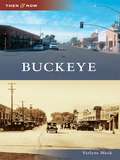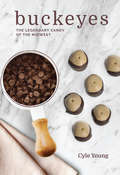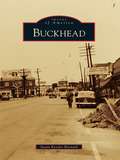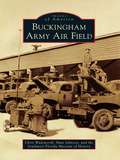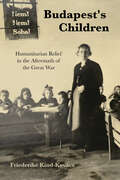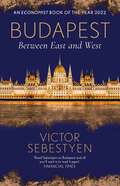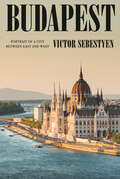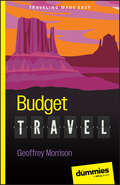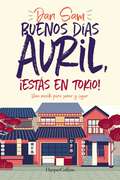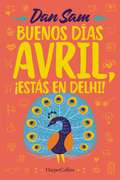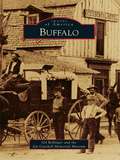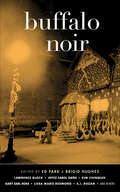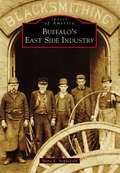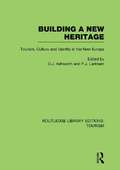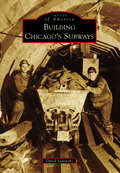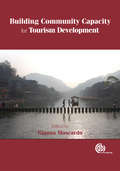- Table View
- List View
Buckeye
by Verlyne MeckWith a population of more than 48,000, Buckeye is the ninth-fastest growing municipality in the United States. The town's rapid growth has left many longtime residents wondering what happened to the place where they grew up. Originally an agricultural community, Buckeye has embraced the 21st century, becoming a hub for the affordable housing market in the Valley of the Sun. Buckeye's colorful history is told by an Arizona Culture Keeper and lifelong resident of the Buckeye Valley, Verlyne Meck, who has woven a tapestry of words and images that tell the unique story of the Buckeye Valley.
Buckeyes: The Legendary Candy of the Midwest
by Cyle YoungWhat goes better together than chocolate and peanut butter? This match made in heaven has delighted young and old alike for decades. In the Midwest, these two delicious ingredients are combined into a sweet treat named after an Ohio tree nut: the buckeye. These little round balls of peanut buttery goodness—rolled and dipped in chocolate, of course—appear on platters at fan tailgates, church potlucks, family gatherings, and on cash register displays. They have become a staple of Midwestern culture and even have their own Buckeye Candy Trail through the state of Ohio. Midwestern native, author, and food lover Cyle Young reveals the history of the buckeye tree and the stories, folklore, and superstitions that accompany the famous nut. From the buckeye's place in the presidential campaign of William Henry Harrison to Ohio State's self-proclaimed biggest football fan, Buckeyes includes fascinating tidbits and stories for any candy lover. Young also shares which stores on the trail still make the buckeye candies the traditional way—by hand. Alongside classic recipes for the candy itself and sweet treats inspired by buckeye flavors—cakes, brownies, beverages, and more—are numerous tips on how to choose your peanut butter and chocolate, the many ways to melt your chocolate, and other secrets to help you become a buckeye connoisseur.
Buckhead
by Susan Kessler BarnardBuckhead, a community four miles from downtown Atlanta, began approximately 6,000 years ago when the Paleo-Indians lived along the Chattahoochee River. By the mid-1700s, the Muscogee (Creek) Indians lived there in the village of Standing Peach Tree. They ceded a major portion of their land to Georgia in 1821, and from that cession came Atlanta and Buckhead. Settlers arrived and operated river ferries, mills, and farms. When Henry Irby opened a tavern in 1838 and hung a buck's head--either over the door or on a yard post--the area became known as Buck's Head. After the Civil War, black neighborhoods, schools, and potteries were established. Around the turn of the century, some Atlanta residents bought land in Buckhead, built cottages, and operated small farms. The streetcar was extended to Buckhead in 1907, and friends followed friends to the community. Images of America: Buckhead is an album of this once quiet rural community before it was annexed to the City of Atlanta in 1952.
Buckingham Army Air Field (Images of America)
by Chris Wadsworth Matt Johnson Southwest Florida Museum of HistoryFor most people in Southwest Florida, the name Buckingham is just one more dot on a map--a rural area east of U.S. Interstate 75. But for a few years, it was so much more. Starting in 1942, it was the site of the Buckingham Army Air Field--home to some 16,000 men and women supporting the United States' World War II efforts. Airplanes roared in the skies over Lee County and reflected off the azure waters of the Gulf of Mexico as tens of thousands of young men trained as aerial gunners. Learning to target and bring down enemy aircraft with their guns was critical to America's success in both the European and Pacific theaters. On the ground, trucks rumbled across the mammoth base, soldiers marched in review under the hot Florida sun, and an entire town sprang up on what was once swampland. Barracks were built, along with stores, nightclubs, churches, and even a hospital with its own baby ward. Today the memories of Buckingham Army Air Field can be found hiding in plain sight, including a working airport that was once the heart of the base.
Budapest's Children: Humanitarian Relief in the Aftermath of the Great War (Worlds in Crisis: Refugees, Asylum, and Forced Migration)
by Friederike Kind-KovácsIn the aftermath of World War I, international organizations descended upon the destitute children living in the rubble of Budapest and the city became a testing ground for how the West would handle the most vulnerable residents of a former enemy state.Budapest's Children reconstructs how Budapest turned into a laboratory of transnational humanitarian intervention. Friederike Kind-Kovács explores the ways in which migration, hunger, and destitution affected children's lives, casting light on children's particular vulnerability in times of distress. Drawing on extensive archival research, Kind-Kovács reveals how Budapest's children, as iconic victims of the war's aftermath, were used to mobilize humanitarian sentiments and practices throughout Europe and the United States. With this research, Budapest's Children investigates the dynamic interplay between local Hungarian organizations, international humanitarian donors, and the child relief recipients. In tracing transnational relief encounters, Budapest's Children reveals how intertwined postwar internationalism and nationalism were and how child relief reinforced revisionist claims and global inequalities that still reverberate today.
Budapest: Between East and West
by Victor Sebestyen'The most accessible and authoritative history of the city in a generation' Times Literary SupplementBudapest has always been an important place. Almost at the centre of Europe, it is at the crossroads of geographical regions and of civilizations, at the intersection of ancient trade routes. Mountains that gradually slope into gentle hills converge on a great river, the Danube, and the regions of Buda and Pest sprang up on either side.Throughout history the centre of gravity in Budapest and among Hungarians has shifted between this division of East and West - culturally, politically, emotionally. Invaders have come and gone, empires have conquered, occupied for centuries or decades, and left a few footprints behind: the remains of a Roman bath house complete with wonderfully preserved mosaics stand next to a Soviet-style 'five-year-plan' apartment block. The city bears the scars of the rise and fall of multiple empires, two world wars, fascism, Nazi German occupation, Soviet Communism. It has been home to some of the world's greatest writers, artists and musicians. Hungary is a place of extremes, a small country that has often in history punched well above its weight. At many moments, events that began in Budapest have proved to be of world significance. This is the story of that tumultuous, often divided, but always fascinating city.
Budapest: Between East and West
by Victor SebestyenBudapest has always been an important place. Almost at the centre of Europe, it is at the crossroads of geographical regions and of civilizations, at the intersection of ancient trade routes. Mountains that gradually slope into gentle hills converge on a great river, the Danube, and the regions of Buda and Pest sprang up on either side.Throughout history the centre of gravity in Budapest and among Hungarians has shifted between this division of East and West - culturally, politically, emotionally. Invaders have come and gone, empires have conquered, occupied for centuries or decades, and left a few footprints behind: the remains of a Roman bath house complete with wonderfully preserved mosaics stand next to a Soviet-style 'five-year-plan' apartment block. The city bears the scars of the rise and fall of multiple empires, two world wars, fascism, Nazi German occupation, Soviet Communism. It has been home to some of the world's greatest writers, artists and musicians. Hungary is a place of extremes, a small country that has often in history punched well above its weight. At many moments, events that began in Budapest have proved to be of world significance. This is the story of that tumultuous, often divided, but always fascinating city.
Budapest: Portrait of a City Between East and West
by Victor SebestyenAN ECONOMIST BEST BOOK OF THE YEAR • A vivid and enthralling account of the historical and cultural events that defined Budapest, a unique city in the heart of Europe, on the fault line between East and West—from the critically acclaimed author of Lenin&“A compelling portrait of one of the most important cities in Europe. Full of sharp insights, elegant writing and vivid characters.&” —Andrew Roberts, author of The ChiefVictor Sebestyen has written a sweeping, colorful and immersive history of the capital of Hungary, from the fifth century to the present day: a metropolis whose location in Europe has marked it as a crucial city—at times rich and prosperous, at times enduring unbearable hardship. It has stood at the center of the world-changing historical developments for hundreds of years: the Muslim invasion, The Reformation, both World Wars, fascism, the Holocaust and Communism.Sebestyen mixes colorful details and anecdotes about the people, streets and neighborhoods of his hometown with its rich cultural legacy of literature, music, and architecture. He shows how its people have shifted culturally, politically and emotionally between East and West, through many revolutions, bloody battles, uprisings, and wars of conquest won and lost. He vividly brings to life the many rulers: the ruthless early Magyar, Hun, and Mongol chieftains, celebrated medieval kings and princes, Ottoman Turks, and the Hapsburgs, including the beloved Empress Elisabeth (&“Sisi&”). We also learn about colorful figures in politics, the arts and the sciences, among them Theodor Herzl, father of modern political Zionism; film pioneer Alexander Korda who held court with the director of Casablanca, Michael Curtiz, young reporter Billy Wilder, and photographer Robert Capa in the glamorous New York Café still going today; Edward Teller, inventor of the H bomb; and Countess Elisabeth Báthory, a cousin of the King of Poland, who became a serial killer, among many others.Sebestyen&’s compelling history of Budapest is a lively page-turner as well as being uniquely revelatory and authoritative account of one of the most important cities of Europe.
Budget Travel For Dummies
by Geoffrey MorrisonTips and tricks for stretching your travel budget all the way around the world Budget Travel For Dummies will help you plan your next vacation and make it affordable, with tips on how to maximize your budget and squeeze amazing experiences out of every penny. Written by a travel expert who has visited 60 countries across 6 continents, this book will help you find the best deals, including cheap flights and accommodations. You’ll learn how to pick a destination, set and stick to a budget, minimize bank and credit card fees, and manage health and travel insurance. For the adventurer within you, this guide is full of tips on traveling without a plan, living for months with just carry-on luggage, and staying flexible in case you need to change your plans. Yes, you can afford that bucket-list trip. Get insider tips on finding cheaper flights and accommodations Pick destinations and plan once-in-a-lifetime trips that won’t break the bank Learn how to navigate passport and visa issues while abroad Avoid common mistakes that can make travel needlessly expensiveThis book is for anyone who wants to travel, or travel more, but doesn’t have the budget to stay in 5-star resorts. Jump into the adventure you’ve always dreamed of, with Budget Travel For Dummies.
Buenos días Avril, ¡estás en Tokio!: Una novela para soñar y viajar
by Dan SamEn Buenos días Avril, ¡estás en Delhi!, conocimos a Avril Santana, una chica linda y sumamente inteligente quien realizó un viaje a Indiacon su mamá, donde encontró a su primer amor, peroun suceso extraordinario le hizo revalorar a los amigos, la familia y el amor.La secuela, Buenos días Avril, ¡estás en Tokio! continúa con la saga de las aventuras de esta joven de 16 años que, después de la India, descubre un nuevo mundo en Japón.La continuación de esta novela es un viaje a películas, intérpretes y canciones de la cultura pop, así como algunos acontecimientos ocurridos en la historia contemporánea como el ocurrido el 6 de agosto de 1945 en Hiroshima.Good morning Avril. You are in Tokyo!In Good Morning Avril, You're in Delhi, we met Avril Santana, a pretty and highly intelligent girl who took a trip to India with her mother, where she met her first love, but an extraordinary event made her re-evaluate friends, family and love.The sequel, Good Morning Avril, You're in Tokyo! continues the saga of the adventures of this 16-year-old who, after India, discovers a new world in Japan.The continuation of this novel is a journey to movies, performers and songs of pop culture, as well as some events in contemporary history such as the one that occurred on August 6, 1945 in Hiroshima.
Buenos días, Avril: Estás en Delhi
by Dan SamAvril Santana está a punto de cumplir quince años y no ha besado a nadie. A pesar de ser una chica linda y sumamente inteligente, ha preferido mantenerse alejada de todos porque su mamá, Mariana Valiani, quien pasa por una crisis matrimonial, la avergüenza en todo momento. Avril busca refugio en el CASI: el Club de los Alumnos Sobresalientes Inadaptados de su escuela, donde conoce a su mejor amigo, Benjamín Choep Wolinski quien sufrirá la discriminación y bullying por descubrirse gay.Tras un bochornoso incidente, Mariana decidé viajar a India para inscribirse en un detox emocional que descubrió mientras leía en una revista de sociales. Avril decide acompañarla para evitar un desastre mayor y le pide a Benjamín que la acompañe. En India, Avril encontrará a su primer amor mientras que su mamá y Bencho vivirán una experiencia que los cambiará para siempre. Su viaje se ve interrumpido por un suceso extraordinario con un desenlace que les permitirá revalorar a los amigos, la familia y el amor.
Buffalo
by Gil Bollinger Jim Gatchell Memorial MuseumBuffalo, the county seat of Johnson County in northeastern Wyoming, began in 1878 as an army town adjacent to Fort McKinney (1877-1894). Since that foundation was laid, Buffalo has been witness to gold prospectors and settlers as a waypoint along the Bozeman Trail, nearby battles during the ensuing Indian Wars, and the Cattle War of 1892. Those events and their associated hard times helped forge the town's unique heritage and culture and made its place in American history significant. It was recently referred to as "an epicenter of Western frontier history" by local museum educator Bob Edwards. Buffalo's site, at the boundary between the Big Horn Mountains and the Northern High Plains, is not only historic but particularly beautiful, and it also provides superb grasslands for cattle and sheep ranching. Those industries, plus mining, lumbering, and tourism, make up the community's present-day economy.
Buffalo Everything: A Guide To Eating In The Nickel City
by Arthur BovinoExplore the classic and modern food traditions of Buffalo Buffalo isn’t just a city full of great wings. There is a great hot dog tradition, from Greek- originated “Texas red hots” to year-round charcoal-grilling at Ted’s that puts Manhattan’s dirty water dogs to shame. This is also a city of great sandwiches. It’s a place where capicola gets layered on grilled sausage, where sautéed dandelions traditionally make up the greens in a comestible called steak- in-the-grass, and chicken fingers pack into soft Costanzo’s sub rolls with Provolone, tomato, lettuce, blue cheese dressing, and Frank’s RedHot Sauce to become something truly naughty. Food and travel writer Arthur Bovino ate his research, taking the reader to the bars, the old-school Polish and Italian-American eateries, the Burmese restaurants, and the new-school restaurants tapping into the region’s rich agricultural bounty. With all this experience under his belt (and stretching it), Bovino has created the essential guide to food in Buffalo.
Buffalo Noir (Akashic Noir)
by Ed Park Brigid Hughes"From the Irish enclave of South Buffalo and a Niagara Street bar to a costly house in Nottingham Terrace and a once-grand Gothic structure in Elmwood Village, Buffalo's past and present come to life in the offbeat, disturbing, and sometimes darkly comical tales by authors who really know their city."--Kirkus Reviews"Park's introduction, in effect a true-crime case study, is as gripping as any of the 13 stories set in or around Buffalo, N.Y., in this strong Akashic noir volume, whose contributors include several mystery heavyweights....Those curious about the criminal side of the second-biggest city in New York will be rewarded."--Publishers Weekly"12 original short stories by established local authors with flawless credentials....Together, the stories cover cityscapes well-known to Buffalonians--to name a few, Elmwood Avenue, Niagara Street, Black Rock, North Park, Delaware Park, and Allentown. Local landmarks Peace Bridge and the Anchor Bar made it in there, too."--Examiner.com"A very nice collection of stories."--Journey of a BooksellerAkashic Books continues its groundbreaking series of original noir anthologies, launched in 2004 with Brooklyn Noir. Each story is set in a distinct neighborhood or location within the city of the book.Featuring brand-new stories by: Joyce Carol Oates, Lawrence Block, Ed Park, Gary Earl Ross, Kim Chinquee, Christina Milletti, Tom Fontana, Dimitri Anastasopoulos, Lissa Marie Redmond, S.J. Rozan, John Wray, Brooke Costello, and Connie Porter.Buffalo, New York, is still the second-largest metropolis in the state, but in recent years its designation as the Queen City has been elbowed aside by a name that's pure noir: The City of No Illusions. Presidents came from here; and in 1901, a president was killed here while visiting the Pan-American Exposition, by a man who checked into a hotel under a name that translates as Nobody.As Buffalo saw its prosperity wane, those on the outside could only see harsh winters and Rust Belt grit, chicken wings and sports teams that came agonizingly close. (Vincent Gallo's Buffalo 66 is less the doomed quest of a would-be assassin than the collective fever dream of every Bills fan.)Anyone who has spent more than a few days in Buffalo will tell you that this city can spar with any other major American metropolis in the noir arena. This highly anticipated entry in the Akashic Noir Series includes stories from Buffalo-affiliated mystery titans as well as up-and-comers.
Buffalo's East Side Industry (Images of America)
by Shane E. StephensonBy 1832, when Buffalo was incorporated as a city, the East Side represented a vast forested area and farmland cut with the beginnings of the major arterials of Genesee, Sycamore, Broadway, William, Clinton, and Seneca. These streets were laid out in 1826 and represented the seeds of the East Side's explosive growth. Along these radial thoroughfares, the development of railroads and the Buffalo Belt Line, constructed in 1883, created a semicircle pattern that outlined the East Side. Industries began sprouting up, eager to use their proximity to the belt line to transport wares all over the country. Immigrants from Germany, Poland, and Ireland, along with African Americans from northern and southern states, began establishing their lives around these industries. Access to land, water, roads, and rail lines and eager immigrants and natives looking for work led to the development of Buffalo's East Side industry, an immensely diverse industrial base and workforce.
Building A New Heritage: Tourism, Culture And Identity In The New Europe (Routledge Library Editions: Tourism)
by G. J. Ashworth P. J. LarkhamAt the heart of the European debate lies the tension between the idea of European unity and individual state identities and nationalisms. This volume provides an insight into this dichotomy by exploring the role of heritage in the new Europe. The main theme of this book is that a number of possible heritages can be shaped from the European past depending on the purposes for which they are intended. Through different methods of management intervention, heritage can fulfil a variety of functions, becoming a major commercial resource in the form of the tourism industry, or enlisted in the creation and maintenance of place identities. Leading contributors look at different perceptions of heritage by different cultures, and the social and political consequences of heritage planning. The nature of heritage planning for emerging, spatially fragmented state structures is also discussed.
Building Community Capacity for Tourism Development
by Gianna MoscardoTourism has become an important tool for development in rural, remote and peripheral regions in the last 50 years. However, in many places, tourism has failed to produce the promised benefits and often caused negative impacts due to a lack of local entrepreneurial capacity to benefit from tourism business opportunities, inadequate understanding of tourism markets and limited community awareness of tourism and its impacts. Drawing attention to the potential outcomes to communities when using tourism as a development strategy, this book provides a focused analysis of this emerging issue and positive guidance on improving the process of tourism planning and development. Chapters compile evidence and examples of how community capacity for tourism can be built and enhanced using case studies from Asia, Africa, South America, the South Pacific and rural Australia and the United States. Providing models and frameworks that can be applied to any developing area, this book will be useful to both academic researchers and government policy makers interested in tourism and rural development.
Building Grand Central Terminal (Images of Rail)
by Foreword By Jr. Frank Dilorenzo Gregory BilottoBuilt in the heart of the Empire City is the world’s greatest and most iconic railway terminal. A colossal Beaux-Arts style transport nexus, Grand Central Terminal was completed in 1913 from the legacy of the railroad tycoon Cornelius Vanderbilt. The terminal quickly became vital to travel and today accommodates 750,000 people daily. This book documents the construction of Grand Central Terminal, the former Grand Central Depot (1871) and Grand Central Station (1900), and illuminates the incredible story of the terminal that revolutionized transport, developed Midtown Manhattan, and opened railroad access to suburban areas.
Building Human Capital in Tourism and Hospitality: Perspectives from theory and practice
by Edited by Jorge Marques, Joana A. Quintela, Marília Durão and Medéia VeríssimoCareer development in the tourism and hospitality industry has attracted greater attention, leading to a higher recognition of the relevance of formal and industry-specific education and training. New career opportunities emerge as new challenges arise, urging for ongoing and renewed debates surrounding higher-level skills and the development and optimization of human capital. Building bridges between higher education institutions, the industry, and other relevant stakeholders - primarily via needs assessment, curriculum design, and monitoring of on-the-job training practices and processes - is critical to promoting the employability of a graduate-level skilled workforce. This book takes steps towards contributing to higher valuation of tourism and hospitality jobs by: combining theoretical and practical viewpoints from scholars, researchers, and practitioners, showcasing challenges and opportunities associated with managing human capital in tourism and hospitality, offering critical and reflective perspectives on competencies development, graduate employability, and improvement of human resource management practices. It will be of interest to researchers, students, teachers, and professionals who want to further explore the area of human capital in tourism and hospitality.
Building Nevada's Highways
by Elizabeth Dickey Jennifer E. RiddleRoads are rarely given a second thought yet are indispensable to life. Admittedly, a book dedicated to roadways sounds a bit dry. But behind every double-diamond interchange, every pork chop island, and every type of asphalt is a fascinating history of the traveling public. This book reveals the hidden history of building the Silver State's highways since 1917. The next time you take a road trip across Nevada on the Lincoln Highway (US 50) or the Victory Highway (US 40) or follow a rutted road to a once-booming ghost town think of the ingenious and industrious men and women, surveyors, engineers, chemists, and yes, even the teams of mules that built the roads we still travel today.
Building Sustainable Tourism Communities: A Blueprint for the Future (Routledge Insights in Tourism Series)
by Volha Rudkouskaya Shivam Bhartiya Jimenez Ruiz, Andrea EdurneThis book offers a comprehensive framework for fostering sustainable tourism communities, providing actionable strategies to balance economic growth, environmental preservation, and social equity. It serves as a vital resource for professionals and scholars striving to create resilient tourism models.Featuring real-world case studies, actionable frameworks, and interdisciplinary perspectives, the book combines theory with practice to equip readers to address challenges such as climate change, cultural preservation, and stakeholder collaboration effectively. Readers will gain practical insights and tools to design and implement sustainable tourism initiatives as this book explores the crucial interactions between tourism, environmental protection, socio-cultural integrity, and economic growth, drawing on substantial research and case studies.This book is ideal for tourism professionals, policymakers, sustainability advocates, scholars, and students in tourism and environmental studies as well as community leaders seeking to build tourism strategies rooted in sustainability and resilience.
Building of the Oroville Dam, The
by Larry R. MatthewsIn the early 1960s, thousands of construction workers and their families came to Oroville, in Northern California, to help build the largest earth-fill dam in the world. Located nine miles northeast of town, the Oroville Dam would be the cornerstone of the California State Water Project, which would provide flood control, electric power, recreation, and water to California residents. The project was so massive that it would reinvent the look of much of the area; require the building of roads, bridges, and railroads; inundate much of the area's history under hundreds of feet of water; and greatly effect the lives of the residents of Oroville. The successful completion of the project came at a price--34 construction workers died.
Building the Blue Ridge Parkway (Images of America)
by Karen J. Hall FRIENDS of the Blue Ridge ParkwayThe Blue Ridge Parkway began as a dream in the late 1800s and became reality in 1983 when the 469-mile scenic highway was completed. Construction of the Blue Ridge Parkway began in September 1935 at Cumberland Knob. Heavy construction was done by contractors who won bids for the different projects along various sections of the parkway. Civilian Conservation Corps troops took care of the roadsides,landscaping, and structure building. As part of Franklin Roosevelt's New Deal, this project was intended to provide jobs throughout the region. Images of America: Building the Blue Ridge Parkway contains approximately 200 construction photographs of the Blue Ridge Parkway.
Building the Caldecott Tunnel
by Mary Mccosker Mary SolonToday, the Caldecott Tunnel connects Alameda and Contra Costa Counties, located in the San Francisco Bay Area. The original two bores of this tunnel opened in 1937, the same year as the San Francisco-Oakland Bay Bridge, and changed Contra Costa County from an area of small rural communities into one of growing suburbs. But this was not the first tunnel to connect these counties. The Kennedy Tunnel, opened in 1903, was accessed by steep and winding roads and located several hundred feet above today's tunnel. A third bore of the Caldecott Tunnel was opened in 1964 and a long-awaited fourth bore in late 2013. The tunnels have not been without disaster and tragedy over their hundred-plus years of existence, yet they remain an integral part of the commercial, social, and historic fabric of the region.
